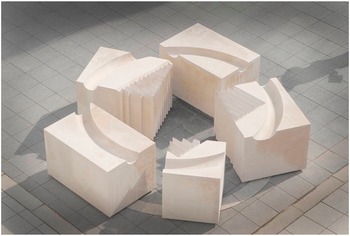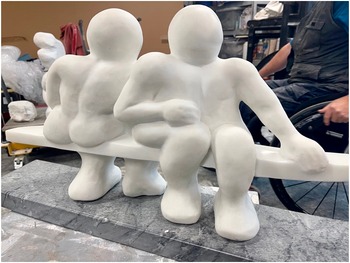“Art points beyond itself”; it transcends style, convention, and the maker (Agamben Reference Agamben and Albert1999, 33). Take the installation of five large and differently sized blocks of white Portland stone arranged in a semi-circular pattern, some twenty-five foot in diameter. Approaching Squareinthecircle? (2007, see Figure 1) by Southport- and London-based sculptor and performance artist Tony Heaton, we first encounter an uninviting fortress made from the same stone as St Paul’s Cathedral, Buckingham Palace, and the Bank of England. Narrow gaps lead to the inside, where hard-edged, solid surfaces are interspersed with zigzagging shapes. Our imagination connects the disparate blocks along a disjointed circle carved into the stones’ tops, mirroring a second ring paved into the floor. Triangular prisms hewn down the middle of three blocks create the illusion of a square in the centre of the figure.

Figure 1: Tony Heaton, Squareinthecircle?, 2007
Note. Photograph by Chris Smart, used with permission of Tony Heaton.
Sitting behind an oversized pot of tea in his dusty, cold studio in Southport, Heaton tells me he is obsessed with layers. With some help, I attempt to unpeel Squareinthecircle? There is the majestic opulence of the grand white stone used in the construction of centres of power. The outer rings resemble tracks left by endlessly circling wheels unable to squeeze through the narrow passageways to a centre dominated by sharp edges and steep stairways. Squareinthecircle? points beyond itself as it stylizes the ambiguity inherent in all things that are made: their capacity to include and exclude, protect and harm, create and destroy.
Later, I come to think of Elaine Scarry’s (Reference Scarry1985) provocation that artifices extend human sentience beyond the boundaries of the body into the outside world: coats mimic and extend outwards our skin; chairs mimic and equally extend outwards the form of the human spine; even rooms or houses act like bodies, putting boundaries around the self while reducing access to the world to doors and windows. Human life is inherently dependent on such prostheses. Even culture can only take shape when the excess of artefacts creates identities: tailors, builders, or merchants; citizens protected by the real or imagined walls of institutional or civic bodies. In Haraway’s (Reference Haraway1985) iconic phrasing, we are all cyborgs.
Scarry (Reference Scarry1985) argues that artefacts absorb pain and, in turn, work inwards and change us. Coats absorb the cold, letting us roam beyond the warming hearth; chairs absorb the weariness of the wanderer; light bulbs free us from the sun’s cycles, absorbing our fear of darkness. But the same artefacts can also become weapons when, instead of absorbing pain, they do violence (Scarry Reference Scarry1985, 39, 176, 316–22).
I begin to see how Squareinthecircle? pointedly stylizes the way in which all things made can simultaneously protect and wound, with sharp edges cleaving soft human or animal skin; how even shelters can exclude us, violating our feeling of safety and belonging. Heaton engages this double play of tool and weapon in other works too: Spring Back (1988), a photograph masquerading as a self-portrait, shows two interlocking motorcycle suspension springs set against a spinal X-ray photogram of the surgical steel springs implanted in Heaton’s back; Gold Lamé (2018) is a gold-painted Invacar suspended face down from a ceiling. Inva(lid)car(riage)s were pale blue, hand-operated, three-wheel, fibreglass microcars distributed to disabled people by the British Ministry of Pensions between 1948 and 1970. These layers produce continuous transformations: a discarded vehicle that was itself a prosthetic replacement of legs is suspended and so deprived of its utility. The original blue (which, Heaton notes, became derogatively known as spaz blue) turns into lamé, a shimmering fabric, which is a play on the word lame, indicating the fickle balance between ability and disability. The Invacar is a failed artefact, not because of an intrinsic lack of functionality or its object-specific aesthetic form, but because of its singularly limited purpose of modifying the disabled body for road mobility—an idea entirely futile when set in relation to the countless other artefacts which remain hostile to disabilities (Guffey Reference Guffey, Guffey and Williamson2020). Abilities and disabilities are therefore not located inside bodies but emerge in the relation of bodies with artefacts (cf. Siebers Reference Siebers2008, 31). The factors deciding between the success or failure of such relations are multiple and complex: built artefacts can be both fortresses and barriers (see also Brown Reference Brown2016), and prostheses that extend mobility can also add to the exclusion of their users.
Heaton’s work is particularly relevant for disability studies, but I think it also offers a view on the role and function of organizations which are central to the production of (as well as themselves being) artefacts, in particular tools, machines, industrial complexes, and digital networks, which massively amplify our reach and power (Anders Reference Anders and Müller2016). How do we, in business and organization studies, legitimize the distinction between desirable artefacts (chairs, coats, shoes) and others that are mere necessities (wheelchairs, medical prostheses, accessibility ramps), and how do these distinctions produce, rather than just reflect, abilities and disabilities, inclusions and exclusions? How do we account for the “double effect” (Monge and Hsieh Reference Monge and Hsieh2020) of artefacts being both tools and weapons, changing their effects in relation to complex networks of relevance? Can our models and frameworks deal with such ambiguity, or do they merely collapse matters into “certainties” that then make us underestimate the violence that can arise from our in(ter)ventions? Are we ready to accept that our theories are capable of doing good and harm (Ghoshal Reference Ghoshal2005)?
These are troubling questions, but there is something else here, too, to do with stability, perfection, order, and form, all of which rank high in management ideology when, as Gregory Bateson (Reference Bateson1972, 13) reminds us, there is always so much more of the unstable, imperfect, disorderly, and formless around us. In his workshop, Heaton shows me a severed head which had fallen off a figure when chiselling a brittle section in a marble block. Rather than being annoyed, Heaton seems delighted by this deficiency (literally by something “falling short”), showing me how he has begun re-carving the headless rump into a new sunken, runtish form. Imperfection also animates the light installation Raspberry Ripple (2018, see Figure 2), where, almost unnoticeably, Heaton omits the letter p in the first word, generating a double play between the incompleteness of the artwork and its meaning in rhyming slang (“cripple”).

Figure 2: Tony Heaton, Raspberry Ripple, 2018
Note. Photograph by the author.
Before leaving his workshop, we unpack a sculpture, Zen Men (2014, see Figure 3), which had just returned from an exhibition: two figures sitting, perched on a polished bench, facing opposite directions. I am surprised how weighty the Carrara marble sculptures are, excessive even for their opulent bodies.

Figure 3: Tony Heaton, Zen Men, 2014
Note. Photograph by the author.
There is something odd about their voluminous, exaggerated features. Compare them to, say, the Venus de Milo (Alexandros of Antioch, between 150–125 bce), who proudly occupies her pedestal, or take Michelangelo’s David (1501–4), leisurely balancing on one leg. Both relate serenely, almost arrogantly, to their environment. Heaton’s Zen Men are lumped together; in one we can just about make out a thinker’s pose, while the other merely slouches. Instead of delicate features, we find plump fingers moulding into hands; feet expand as if their bodies were in slow motion, congealing downwards like a piece of wax on a summer’s day. The clearest shape is an intergluteal cleft separating pert buttocks, indicating that these are living, biological bodies.
And still there is levity; the Zen Men almost float, but with none of the grace or heroism coded in their ancient predecessors. Heaton cites the German painter Baselitz as an inspiration. In a series of paintings called Grosse Nacht (Big Night), Baselitz depicts figures in rough contours, broken skin and clothes, hunched or differently formed: a “new type” for post-war Germany, no longer valorizing heroism, uniformity, and sameness. I try in vain to imagine the Zen Men in uniforms parading equal step, noting instead how friendly they look, almost inviting me to join them on their bench. But then I notice how narrow it is. The hardness of the polished surface offsets the softness of the bodies. They lean into each other for support, their backsides dangling over sharp edges. It takes me even longer to realize that what I took for levity is a defect: the bench has no legs, leaving the figures’ bloated feet to absorb the burden of gravity. Heaton’s new type is left on its own, bereft of support, yet it is perfect in its own way, calm and self-contained in perfect continence.
We began with the idea that art “points beyond itself,” and we get a sense of the “beyond” as a space of imperfection, riven with ambivalences (Luhmann Reference Luhmann and Knodt2000, 141). Put into the language of cause and effect, we find recursive loops that refuse to let meaning or effect settle: now something does good, now harm, and so on. This layering messes with the binary distinctions that frequently underlie management theory (Williams and Mavin Reference Williams and Mavin2012) and instead makes us think and pause to look at the wider patterns that continually change what an artefact (which includes a theory) is or does. I wonder what management studies might look like if we were to ground our claims in such ambiguity and uncertainty, rather than in the soothing but misplaced sense of concreteness that so often follows from rigorous analyses. I am left thinking that if all artefacts are capable of absorbing and meting out pain, and if they produce rather than merely reflect inclusions as well as exclusions, should we not be more hesitant in drawing conclusions and legitimizing interventions? And should we, like artists, not also be tremendously concerned about the wider patterns and relations into which all things are woven, especially if these are too entangled and complex to be neatly represented (see also Pless, Maak, and Harris Reference Pless, Maak and Harris2017)? And, finally, should we perhaps also take delight in the imperfect, average, messy, deficient, or “ugly,” cutting the world and ourselves some slack?
Mike Zundel (m.zundel@liverpool.ac.uk) is professor in organization studies at the University of Liverpool Management School. He is interested in ecological theories, time, and strategy. Together with Robin Holt, he recently published a monograph on the technological mediation of strategy.





